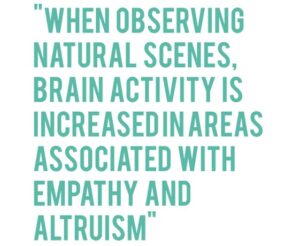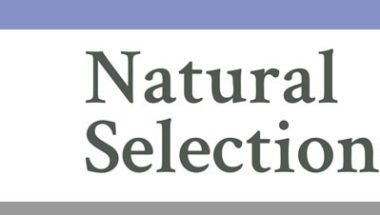“Imagine a therapy that had no known side effects, was readily available, and could improve your cognitive functioning at zero cost.” – Stephen Kaplan, The Restorative Benefits of Nature Toward an Integrative Framework
Human senses evolved to interpret information from their environment. For 5 million years it was information about plants and streams, food production, baby-making and avoiding predators. In the last few hundred years, our senses have become inundated with stressful triggers such as traffic jams, concrete jungles, loud noises, bills, and deadlines that make up our daily experiences. Today, large scale public health problems such as heart disease, obesity, depression, concentration impairment, and pervasive nearsightedness, are all associated with high stress and little time spent outdoors.
In the U.S., adults spend less time outdoors than they do in their cars; less than 5% of their day. Only about 10% of American teenagers spend some time outside every day. Richard Louv, well known for his concept of “nature deficit disorder” has written several books on what he calls the “greatest experiment ever done on our children”, outlining the effects of a childhood removed from nature on mental development. These children fail to develop the parts of their brains that allow them to use relational senses such as balance, trust in activity, relationship to natural environments and, most alarmingly, their own empathetic caring for the environment and other living beings.  For many of us who were fortunate enough to have an outdoor childhood, our fondest memories are of camping trips, building outdoor forts, and trips to the cabin. The prospect of a childhood that is deprived of these experiences is indeed a sad one, yet it is increasingly common.
For many of us who were fortunate enough to have an outdoor childhood, our fondest memories are of camping trips, building outdoor forts, and trips to the cabin. The prospect of a childhood that is deprived of these experiences is indeed a sad one, yet it is increasingly common.
Technology gives us tremendous convenience and access to the web of knowledge that has been collectively woven around the world. It is exciting, entertaining and informative, yet it is not without a cost. Some scientists suggest that technologies are, in a way, ruining our lives. Humans are becoming more and more like fast-twitch animals, adapted to respond to alarms, reminders and two-dimensional screens. This artificial over-stimulation is zapping our ability to concentrate for long periods of time, as well as our ability to appreciate the natural world.
 Korean researchers use functional MRI to watch brain activity in people viewing different images including urban scenes, cars, and phones. These types of images are associated with increased blood flow to the amygdala (which processes fear and anxiety). In contrast, when observing natural scenes, brain activity is increased in the anterior cingulate gyrus and insula; areas associated with empathy and altruism (i.e. nature makes us nicer as well as calmer!). There is a plethora of research from Japan that examines the effects of Shinrin Yoku (‘Forest Bathing’, or the trendy term for spending time in nature), which is repeatedly found to produce measurable reductions in stress hormone (cortisol) levels, blood pressure, and heart rate. They have also found improved emotional awareness, faster problem solving and increased creativity after weekend-long nature retreats. Nature changes how we allocate our attention and whether or not we focus on negative emotions. It provides a break from the “nervous irritation” of city life and lets the neural pathways that allow for relation, relaxation, and problem-solving to synapse freely. It seems, however, that it is not enough to walk to a pretty landscape and snap a few pictures.
Korean researchers use functional MRI to watch brain activity in people viewing different images including urban scenes, cars, and phones. These types of images are associated with increased blood flow to the amygdala (which processes fear and anxiety). In contrast, when observing natural scenes, brain activity is increased in the anterior cingulate gyrus and insula; areas associated with empathy and altruism (i.e. nature makes us nicer as well as calmer!). There is a plethora of research from Japan that examines the effects of Shinrin Yoku (‘Forest Bathing’, or the trendy term for spending time in nature), which is repeatedly found to produce measurable reductions in stress hormone (cortisol) levels, blood pressure, and heart rate. They have also found improved emotional awareness, faster problem solving and increased creativity after weekend-long nature retreats. Nature changes how we allocate our attention and whether or not we focus on negative emotions. It provides a break from the “nervous irritation” of city life and lets the neural pathways that allow for relation, relaxation, and problem-solving to synapse freely. It seems, however, that it is not enough to walk to a pretty landscape and snap a few pictures.
Individuals need to take time to slow down and connect, to breathe the forest air and let their feet be held firmly on the soil.
Luckily, we have started to realize how important a relationship with nature is for our health and there are many movements that aim to teach us how to re-connect with our natural environment:
- The Association of Nature and Forest Therapy Guides and Programs trains educators and has members in Vancouver
- Nature family clubs plan monthly get-togethers – look for clubs in your area on social media
- Forest preschools are quickly becoming popular. Forest schools of Canada has listings of schools available in your area.
- These are just a few of the many great opportunities to get families involved in developing connection to nature. I encourage you to find some that fit for you!
- Free forest therapy starter kit: Natureandforesttherapy.org
- Forest preschool or elementary school for your children: Childnature.ca
- Learn more about forest preschool: Your Guide to BC’s Forest Preschool Programs
References:
Atchley, R.A., Strayer, D. (2012) Creativity in the Wild: Improving Creative Reasoning through Immersion in Natural Settings. PLOS ONE 7(12)
Kaplan, S. (1995) The Restorative Benefits of Nature Toward an Integrative Framework. Journal of Environmental Psychology (15) 169-182.
Li, Q., et al. (2016) Effects of Forest Bathing on Cardiovascular and Metabolic Parameters in Middle Aged Males. Evidence–Based Complementary and Alternative Medicine (2016)
Louv, R. (2008) Last Child in the Woods: Saving our children from Nature-Deficit Disorder. Algonquin Books.
Park, B., Tsunetsugu, Y., et al. (2010) The physiological effects of Shinrin-yoku (taking in the forest atmosphere or forest bathing): evidence from field experiments in 24 forests across Japan. Environmental Health and Preventative Medicine. 15(1): 18-26
Wohllenben, P. (2015) The Hidden Life of Trees; What they feel, how they communicate. Discoveries from a Secret World. Random House Publishing.
Williams, F. (2015) This is your Brain on Nature. National Geographic Magazine




